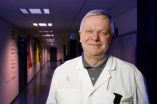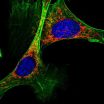(Press-News.org) Researchers at Karolinska Institutet in Sweden have for the first time identified a gene driving the development of pernicious adipose tissue in humans. The findings imply, which are published in the scientific journal Cell Metabolism, that the gene may constitute a risk factor promoting the development of insulin resistance and type 2 diabetes.
Adipose tissue can expand in two ways: by increasing the size and/or the number of the fat cells. It is well established that subjects with few but large fat cells, so-called hypertrophy, display an increased risk of developing type 2-diabetes. In the current study, researchers identified a gene, EBF1, which according to these new findings drive the development of the unhealthy adipose tissue. This gene encodes a protein that controls a set of other genes, a so-called transcription factor, and regulates the formation of new fat cells as well as their metabolic function.
The investigators compared adipose tissue from subjects with small or large fat cells and found that EBF1 was closely linked to hypertrophy. Individuals with large fat cells had markedly lower EBF1 expression in their adipose tissue, displayed altered lipid mobilisation and were insulin resistant. Insulin resistance – a condition characterised by reduced cellular response to the hormone insulin that is released when the blood glucose levels rise after a meal – is an important causal factor underlying the increased risk of diabetes in individuals with hypertrophic adipose tissue. Insulin resistance leads to increased circulating levels of glucose and lipids in the blood.
In collaboration with Professor Mark C. Horowitz at Yale School of Medicine, U.S. the researchers also investigated genetically modified mice expressing lower levels of the murine variant of the human EBF1-gene. It turned out that these mice developed adipose hypertrophy and displayed increased lipid mobilisation from fat cells. When the mice were put on high-fat diet they became insulin resistant.
"Our findings represent an important step forward in the understanding of how adipose tissue links to the development of metabolic disease", comments Professor Peter Arner, one of the principal investigators at Karolinska Institutet along with Hui Gao, Niklas Mejhert and Mikael Rydén. "This is the first time someone has identified a gene which may cause malfunctioning adipose tissue in man. In the future, it might be possible to develop drugs that improve EBF1 function in adipose tissue, which could be used to treat type 2-diabetes."
INFORMATION:
The research at Karolinska Institutet was conducted at the Department of Biosciences and Nutrition and the Department of Medicine, Huddinge, with financial support from the Swedish Research Council, the Novo Nordisk Foundation, the European Association on the Study of Diabetes together with Eli-Lilly, the Swedish Diabetes Foundation, Diabetes Wellness Fund, the Strategic Research Program in Diabetes at Karolinska Institutet, The Knut andAlice Wallenberg Foundation and the Jonasson donation.
Publication: 'Early B Cell Factor 1 Regulates Adipocyte Morphology and Lipolysis in White Adipose Tissue', Hui Gao, Niklas Mejhert, Jackie A. Fretz, Erik Arner, Silvia Lorente-Cebrián, Anna Ehrlund, Karin Dahlman-Wright, Xiaowei Gong, Staffan Strömblad, Iyadh Douagi, Jurga Laurencikiene, Ingrid Dahlman, Carsten O. Daub, Mikael Rydén, Mark C. Horowitz, and Peter Arner, Cell Metabolism, online 22 May 2014, 1 July 2014 issue.
More about Karolinska Institutet - a medical university: ki.se/english
Gene behind unhealthy adipose tissue identified
2014-05-22
ELSE PRESS RELEASES FROM THIS DATE:
Computer models helping unravel the science of life?
2014-05-22
Scientists have developed a sophisticated computer modelling simulation to explore how cells of the fruit fly react to changes in the environment.
The research, published today in the science journal Cell, is part of an on-going study at The Universities of Manchester and Sheffield that is investigating how external environmental factors impact on health and disease.
The model shows how cells of the fruit fly communicate with each other during its development. Dr Martin Baron, who led the research, said: "The work is a really nice example of researchers from different ...
Supportive tissue in tumors hinders, rather than helps, pancreatic cancer
2014-05-22
HOUSTON – Fibrous tissue long suspected of making pancreatic cancer worse actually supports an immune attack that slows tumor progression but cannot overcome it, scientists at The University of Texas MD Anderson Cancer Center report in the journal Cancer Cell.
"This supportive tissue that's abundant in pancreatic cancer tumors is not a traitor as we thought but rather an ally that is fighting to the end. It's a losing battle with cancer cells, but progression is much faster without their constant resistance," said study senior author Raghu Kalluri, Ph.D., M.D., chair ...
Blocking pain receptors extends lifespan, boosts metabolism in mice
2014-05-22
Blocking a pain receptor in mice not only extends their lifespan, it also gives them a more youthful metabolism, including an improved insulin response that allows them to deal better with high blood sugar.
"We think that blocking this pain receptor and pathway could be very, very useful not only for relieving pain, but for improving lifespan and metabolic health, and in particular for treating diabetes and obesity in humans," said Andrew Dillin, a professor of molecular and cell biology at the University of California, Berkeley, and senior author of a new paper describing ...
One molecule to block both pain and itch
2014-05-22
Duke University researchers have found an antibody that simultaneously blocks the sensations of pain and itching in studies with mice.
The new antibody works by targeting the voltage-sensitive sodium channels in the cell membrane of neurons. The results appear online on May 22 in Cell.
Voltage-sensitive sodium channels control the flow of sodium ions through the neuron's membrane. These channels open and close by responding to the electric current or action potential of the cells. One particular type of sodium channel, called the Nav1.7 subtype, is responsible for ...
Deciphered the process through which cells optimize metabolism to burn sugars or fats
2014-05-22
To guarantee efficient use of nutrients, cells have systems that permit them to capture and transport the available nutrient molecules to their interior. But if several nutrients are available, cells can select those that are of most interest and discard undesired molecules.
Inside cells, nutrients are conducted to the mitochondria, the specialized cell organelles in which nutrients are combusted to release the energy held in their chemical bonds. Both sugars (glucose) and fats (fatty acids) are 'burned' in mitochondria, but these organelles need to adjust their molecular ...
New insight into stem cell development
2014-05-22
The world has great expectations that stem cell research one day will revolutionize medicine. But in order to exploit the potential of stem cells, we need to understand how their development is regulated. Now researchers from University of Southern Denmark offer new insight.
Stem cells are cells that are able to develop into different specialized cell types with specific functions in the body. In adult humans these cells play an important role in tissue regeneration. The potential to act as repair cells can be exploited for disease control of e.g. Parkinson's or diabetes, ...
Study: Some pancreatic cancer treatments may be going after the wrong targets
2014-05-22
ANN ARBOR, Mich. — New research represents a significant change in the understanding of how pancreatic cancer grows – and how it might be defeated.
Unlike other types of cancer, pancreatic cancer produces a lot of scar tissue and inflammation. For years, researchers believed that this scar tissue, called desmoplasia, helped the tumor grow, and they've designed treatments to attack this.
But new research led by Andrew D. Rhim, M.D., from the University of Michigan Comprehensive Cancer Center, finds that when you eliminate desmoplasia, tumors grow even more quickly and ...
'I can' mentality goes long way after childbirth
2014-05-22
The way a woman feels about tackling everyday physical activities, including exercise, may be a predictor of how much weight she'll retain years after childbirth says a Michigan State University professor.
James Pivarnik, a professor of kinesiology and epidemiology at MSU, co-led a study that followed 56 women during pregnancy and measured their physical activity levels, along with barriers to exercise and the ability to overcome them.
Six years later, the research team followed up with more than half of the participants and found that the women who considered themselves ...
What is being said in the media and academic literature about neurostimulation?
2014-05-22
Over the past several decades, neurostimulation techniques such as transcranial direct current stimulation (tDCS) have gradually gained favour in the public eye. In a new report, published yesterday in the prestigious scientific journal Neuron, IRCM ethics experts raise important questions about the rising tide of tDCS coverage in the media, while regulatory action is lacking and ethical issues need to be addressed.
TDCS is a non-invasive form of neurostimulation, in which constant, low current is delivered directly to areas of the brain using small electrodes. Originally ...
EuroPCR 2014 examines whether science translates into practice with new session format
2014-05-22
22 May 2014, Paris, France: The value of analysing published clinical trials and the benefit of informed discussion were highlighted yesterday when the ACCOAST trial data were discussed in a new session format—Will this trial change my practice?— at EuroPCR 2014. ACCOAST trial results demonstrate that pre-treatment with prasugrel in NSTEMI patients undergoing percutaneous coronary intervention (PCI) is inferior to treatment with the drug after angiography. Several other trials are also being scrutinised in the same format, which ends with a discussion with the audience ...




